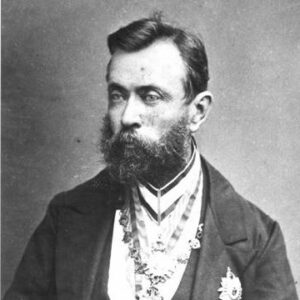Ferdinand von Mueller founded the National Herbarium of Victoria, a German-Australian geographer and botanist. He worked as the government botanist for the then-colony of Victoria and then as the director of the Royal Botanic Gardens in Melbourne over his long career. He was one of Australia’s most distinguished nineteenth-century scientists, and he began his career in botany at an early age. He was born in Germany and began his study of the vegetation of Schleswig-Holstein when he was 15 years old, a project that would take him several years. He went on to Kiel University to study botany under Professor Ernst Ferdinand Nolte and got his doctorate with a thesis on the plants of Schleswig’s southern districts. His fascination with flora from various parts of the world evolved to a passion for travel and adventure. He travelled to Australia as a young man, where he continued his botanical research and investigated the areas around Mount Arden and Mount Brown. Soon after, he established himself as a respected botanist, and Governor Charles La Trobe nominated him as the official botanist for Victoria. He spent a lot of time on scientific missions and is credited with discovering approximately 800 new species in Australia. Mueller never married and spent his entire life pursuing scientific goals.
Childhood and Adolescence
Frederick Mueller, commissioner of customs, and his wife Louise had Ferdinand Jacob Heinrich von Mueller on June 30, 1825. He had a lot of siblings, but only a few of them lived to adulthood. When he was a child, both of his parents perished.
Following the death of his parents, he was raised by his grandparents. He obtained a decent education and, at the age of 15, was apprenticed to a chemist. From a young age, he was fascinated by flora and began researching the vegetation of Schleswig-Holstein.
After clearing his pharmacy exams, he went to Kiel University to study botany under Professor Ernst Ferdinand Nolte. In 1847, he received a Ph.D. for a thesis on the flora of southern Schleswig.
The Career of Ferdinand
Bertha, his sister, was recommended to move to a warmer area for her health around this time. Mueller and his two surviving sisters came to Australia in December 1847 on the advice of the eminent botanist Ludwig Preiss.
He went to work for Moritz J. Heuzenroeder as a chemist. He spent his free time studying the local flora and visiting areas like Mount Gambier, the Flinders Ranges, and Lake Torrens. During his first year, he also explored Mount Arden and Mount Brown.
He bought many acres of property with the intention of starting a farm. This strategy, however, did not work as planned, and he returned to his previous job. At 1852, he published a paper on ‘The Flora of South Australia’ in the Linnean Society of London, which garnered him notoriety in botanical circles.
Governor Charles La Trobe appointed Mueller as official botanist for Victoria in 1853. He traveled about Port Albert and Wilson’s Promontory in this job, gathering a variety of specimens with possible industrial and therapeutic use.
He was a member of the Victorian Institute for the Advancement of Science, subsequently known as the Philosophical Institute of Victoria, from 1854 until 1872.
He was named botanist to the North West Australia Expedition in 1855, which set sail from Sydney in July of that year. It was a long journey that spanned 16 months and covered over 5,000 kilometers. Mueller looked at almost 2,000 species, roughly 800 of which were new to Australian botany.
He was named director of the Botanical Gardens after his return to Melbourne in 1857 while continuing to work as a government botanist. He organized for the establishment of a herbarium while in this role, and he contributed his enormous collections to it. He was also in charge of trading seeds and plants with botanists from all across Australia, Europe, and North America.
Ferdinand von Mueller saw the potential for a variety of flora species to be used in medicine and business. He recognized the commercial use of Victorian timber in the production of charcoal, gunpowder, tar, vinegar, spirits, and potash, as well as eucalyptus’ therapeutic potential. He assisted the residents of Victoria in earning financial advantages by being aware of the practical uses of his findings, but not generating any money himself.
He wrote over 800 papers and major works on Australian botany, including ‘The Natural Capabilities of the Colony of Victoria’ (1875), ‘Select Plants Readily Eligible for Industrial Culture or Naturalization in Victoria’ (1876), several volumes of ‘Fragmenta photographica Australia (1862–1881), and two volumes of ‘Plants of Victoria’ (1860–1865).
His Major Projects
Mueller observed around 2,000 species throughout his long career, about 800 of which were new to Australian botany. He was a key figure in disseminating information about the medical properties of the blue gum (Eucalyptus globulus) around the world, as well as introducing the species to countries in Europe, Africa, and South America’s extratropical regions.
Achievements & Awards
Mueller was awarded as Knight Commander of the Order of St Michael and St George in 1879, after being elected a fellow of the Royal Society in 1861.
The Royal Society of New South Wales awarded him the Clarke Medal in 1883.
In addition, he was awarded the Royal Medal (1888).
Personal History and Legacy
Ferdinand von Mueller did not marry, despite being briefly engaged to Euphemia Henderson in 1863 and Rebecca Nordt in 1865. He was close to his sisters, one of whom died before him.
At the age of 71, he died on October 10, 1896.
Lerista Mueller is an Australian lizard species named after him.
Estimated Net worth
Unknown.


